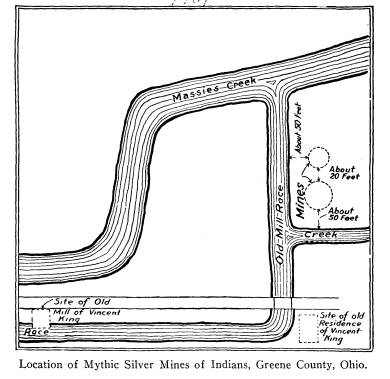Ohio History Journal
SILVER MINES OF
OHIO INDIANS.
PROFESSOR R. S. KING.
[We occasionally have had inquiries
concerning the history or
myth, if it was merely traditionary,
concerning some silver mines worked
by the Indians, which mines were
supposed to have been located near
Old Chillicothe, Greene County, Ohio. We
have never been able to
secure any definite information in
regard to the same until we received
the following from Professor R. S. King,
now of the University of
Arizona, Tucson, Arizona.-EDITOR]
Some time ago I mentioned to my father,
Mr. William
Harrison King, that I had once upon a
time read a legend of
silver mines located in Greene County,
Ohio. As my father
was born and raised in that county he
has vivid recollections of
events that happened in the early days. The
following is his
version of these mines and their
locations:
According to some of the prisoners of
the Indians they
were made to pack heavy loads from a distance up Massie's
Creek down to Old Chillicothe, now Old
Town, Ohio. These
prisoners were some of the early
pioneers who ventured into
this region before the first settlement
was made. It was re-
lated by these men that the Indians
would blindfold them early
in the morning and march them up the trail along Massie's
Creek for a distance estimated between
three and three and a
half miles. Then they would be left
under guard for a period
of time, usually estimated at about
one-half day, at the end
of which time the Indians who had
departed would return with
material in bundles that was very heavy
for the size of the
package. These heavy bundles or packs
would be forced on
the prisoners and they would be
compelled to carry them to Old
Chillicothe without any rest.
One of these prisoners whose name is not
recalled claimed
that he was able to remove the bandage
partly from his eyes
and that the Indians did not leave the
party but remained with
them so that the prisoners would think
that the material had
been brought to them from a distance. He
also claimed that
(114)
|
Silver Mines of Ohio Indians. 115 he saw them load up the packs and that they were bars of silver which came from a mine near by. As this prisoner had a reputation among his companions of "handling the truth in rather a reckless manner" not much faith was put in his story. However the tale was told from time to time and efforts have been made to locate this mythical mine. It might be said that the claim was also made that the Indians buried part of this |
|
|
|
wealth near Old Chillicothe and carried a part of it north where it was buried. Shortly after Old Chillicothe was destroyed by Gen. George Rogers Clarke and those who had the location of the wealth were either killed later or did not return to claim the silver. Mr. James Stevenson, a son of Samuel Stevenson of near Lexington, Kentucky, moved into Ohio about 1796 or 1797 and |
116 Ohio Arch. and Hist.
Society Publications.
located his land in the region of these
mines. He afterward
married Miss Anna Galloway, who was the
daughter of Wil-
liam Galloway, who lived near Paris,
Kentucky. A daughter,
Jane Stevenson, married Mr. Vincent
King, who later purchased
from his father-in-law the land that,
according to what follows,
contained these mines. As soon as this
land was acquired
Vincent King erected thereon a flour
mill, the approximate lo-
cation of which is shown on the
accompanying map. In dig-
ging the race a short distance from the
bed of Massie's Creek
small flat stones were thrown out that
contained or rather had
engraved on their sides some marking or
hieroglyphics. No-
thing was thought of this at the time
but later some men who
were interested in trying to locate
these mythical mines heard
of it and near by they found what
appeared to be two round
holes about twelve feet in diameter that
seemed to be filled up
with rocks. They started to sink a hole
or shaft beside one
of these rock-filled holes and as far
down as they went this
rock fill continued. Their digging was
in earth. This showed
beyond a doubt that there had been a
hole or shaft here at
some former time that had been filled
with "nigger-heads" and
other rock. As the surrounding ground
was all deep earth and
no rocks in the soil it seemed certain
that the lost mine had
been found but the digging was
discontinued because of water
encountered. Considering the finding of
peculiar marked rocks
at the time of digging the race and the
two circular holes filled
with rock leads one to think that
perhaps there may have been
some work of some sort done here by the
Indians or their prede-
cessors.
The accompanying map shows the
approximate location of
these two circular holes. I certainly
would like to see this
"particular" mine
investigated, not that it is likely to disclose
any hidden wealth but that it might be
worth while for what it
would yield in an archaeological way.
The above account may have been
elaborated extensively
but I believe that all the facts are set
forth. I trust that this
paper may bring out further information
in connection with this
myth. I might say that this land is
located just north of Wil-
berforce University, Greene County,
Ohio.
